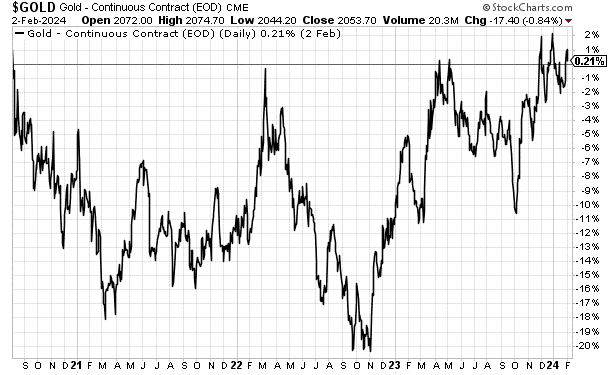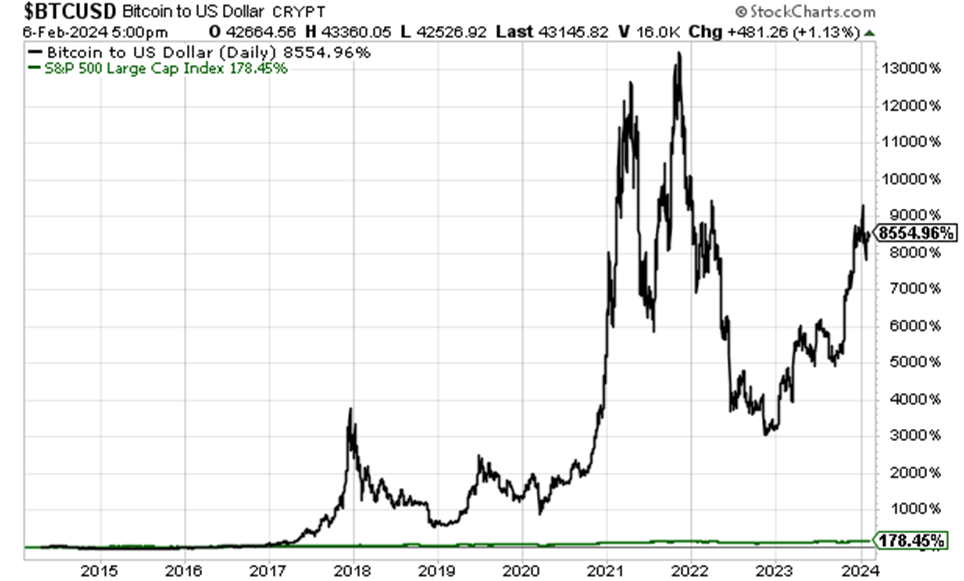The government’s spending problem … two asset classes to help protect your wealth … where Eric Fry and Luke Lango see prices going … a before-and-after that explains why Americans are broke
From billionaire hedge fund manager Paul Tudor Jones on CNBC’s Squawk Box yesterday:
We’ve got a 6%, 7% budget deficit. We’re fast-forwarding consumption like crazy.
It should be going gangbusters because we got an economy on steroids. It’s unsustainable.
The only question is does that manifest itself in the markets, or when does that manifest itself in the markets.
It could be this year; it could be next year. Productivity may mask and it might be three or four years from now but clearly, clearly, we’re on an unsustainable path.
On Sunday, Federal Reserve Chairman Jerome Powell echoed this sentiment when speaking on 60 Minutes:
In the long run… the U.S. federal government is on an unsustainable fiscal path…
It’s probably time, or past time, to get back to an adult conversation among elected officials about getting the federal government back on a sustainable fiscal path…
We’re borrowing from future generations. And every generation really should pay for the things that it needs… and not hand the bills to our children and grandchildren.
We can see this “unsustainable path” by looking at the ratio of the U.S. federal debt to GDP, which currently clocks in at 122.72%. In other words, for every $1 that our economy creates, our federal government owes $1.22 in debt.
We’ve spilled an abundance of ink here in the Digest profiling this enormous problem. We won’t rehash those details in today’s Digest. Instead, let’s look at how to protect your wealth.
It goes without saying that investing in high-quality stocks is one of the best things you can do. Especially the stocks of companies that pay healthy dividends and have pricing power to help protect margins.
But today, let’s move beyond stocks. To help you diversify your holdings, let’s focus on two assets that, historically, have offered investors a way to protect their wealth as our government’s monetary carelessness destroys our currency.
How will the “refuge of the wary” perform in 2024?
That’s how James Grant once described gold.
Perhaps that nickname is warranted, but in recent years, the performance of the yellow metal has made it appear less “refuge” and more “refuse.”
Though gold set a new all-time-high of $2,135 in December, it has done nothing for nearly four years. It currently trades not even 1% higher than its peak in August 2020.

But as the Fed eyes interest rate cuts, will this finally be the tailwind that gold investors have been waiting for?
Eric Fry, our macro expert and editor of Investment Report, thinks it’s likely.
The specific tailwinds behind gold that could mean “this time it’s different”
Eric points toward four factors that are likely to support a bullish run for gold in 2024.
The first is falling interest rates.
High interest rates increase the attractiveness of income-generating assets. After all, why put your money into gold, paying you nothing, when your money could earn 5% in a savings account? But when interest rates come down, that reduces the opportunity cost of these income-producing assets. Though we don’t know when exactly, rates should be falling here in 2024.
Next, there’s the weakening dollar.
As interest rates fall, we’re likely to see a softer dollar. When the dollar is worth less, it requires more of those dollars to buy the same quantity of gold. This creates upward pressure on gold prices.
Third, we have rising geopolitical tensions.
Perhaps no other asset benefits from global tension as much as gold. As we’ve been covering in the Digest, the situation in the Mideast is deteriorating quickly. And don’t overlook the potential for new tension with China over Taiwan. While we hope neither of these situations escalates, if they do it will only help gold prices.
Finally, there’s buying pressure from global central banks.
Eric notes that in 2022, central banks bought more than 1,000 metric tonnes of gold. That’s equal to more than one-quarter of the world’s annual gold production. Eric is clear that this buying, alone, will not trigger a major gold rally. But it could help power a rising price trend.
Here’s Eric’s big-picture take:
As recent history proves, there is even a time to favor “non-procreative” assets over procreative ones… like the 10-year stretch from 1999 to 2009.
During that decade-long span, non-procreative gold advanced 230%, while Berkshire Hathaway shares fell 6%!
Although I’m not expecting gold to deliver relative gains of this magnitude, select gold mining stocks could produce handsome results this year.
On Sunday, we learned that UBS has a price target of $2,200 for gold in 2024
That’s about 8% higher than gold’s price as I write Tuesday morning.
Now, that’s not exactly a “retire tomorrow” gain. That’s why Eric is eyeing select gold mining stocks instead of gold itself. The stocks of gold miners tend to mirror gold’s movements, though with far greater volatility (both the good and bad kind).
If you’re looking for the easiest way to play gold and/or gold miners, check out GLD, which is the SPDR Gold Trust and GDX, which is the VanEck Gold Miners ETF.
GLD is engineered to reflect the price of gold bullion. GDX holds top gold miners, including Newmont, Barrick Gold, Agnico Eagle Mines, and Wheaton Precious Metals.
And if you’re contemplating gold, give silver a look while you’re at it. UBS believes it has greater firepower potential than gold in 2024.
From CNBC:
Prospects for gold’s “poorer cousin” are also optimistic, with silver on course to “really, really shine ” …
“In a scenario where the Fed is easing, we think silver can do really well. It tends to outperform a move in gold,” Teves said.
“Silver has been underperforming gold quite a lot. So there is a lot of catching up to do and I think the move could be quite dramatic,” she added.
We’ll keep you updated on both gold and silver.
The second asset to consider as a hedge against government ineptitude is Bitcoin
Whether you’re a Bitcoin fan or foe, the numbers are the numbers. And they suggest that if you’re bearish on Bitcoin, be careful.
Here’s some perspective:
- 10-year return for Bitcoin: 8,554%
- 10-year return for the S&P: 178%
- 5-year return for Bitcoin: 1,169%
- 5-year return for the S&P: 81%
- 2-year return for Bitcoin: 10%
- 2-year return for the S&P: 2%
- 1-year return for Bitcoin: 89%
- 1-year return for the S&P: 20%
For a visual, here’s a 10-year chart comparing Bitcoin (in black) and the S&P (in green) over the last 10 years. You can barely see the S&P due to the enormous scale needed to show Bitcoin’s growth.
Frankly, that’s the point.

To be clear, Bitcoin is not the “chaos hedge” gold is. In fact, Bitcoin brings its own chaos in the form of heightened volatility.
However, like gold, Bitcoin is an effective way to diversify your wealth outside the dollar. And whereas gold’s performance in 2024 is likely to be mild enough to lull you to sleep (that 8% higher target from UBS), Bitcoin’s performance could more closely resemble a white-knuckle rollercoaster ride that leaves you breathless…but far richer.
Bitcoin at $524,000?
That’s what renowned bitcoin analyst PlanB is calling for within four years.
He’s not alone in making an eye-watering projection. Analysts at Blockware Solutions are calling for Bitcoin at $400,000 by the end of the next crypto cycle.
A more tempered forecast comes from global investment group VanEck. It believes Bitcoin will pass $68,997 to set a new all-time-high by Q2 of this year. Based on Bitcoin’s price as I write, that represents a 60% pop by the end of June.
While the scope of Bitcoin’s coming gains is unclear, our crypto expert Luke Lango believes heavy money flows are headed toward the crypto sector. He’s urging investors to act now, ahead of this.
From Luke’s latest issue of Ultimate Crypto:
The crypto markets continued to rebound this week, and we think this is the start of the next big leg higher in this Boom Cycle.
That’s why we just issued our first new crypto buy alerts in a long time.
The technical and fundamental data is telling us that now is the time to be accumulating, before Bitcoin (BTC-USD) makes a run above $50,000 – and before altcoins soar even more.
The event that Luke and the rest of the crypto community are watching
The Halving is an event specific to Bitcoin wherein “bitcoin miners” — think, computer whizzes who solve complex computer puzzles to release new bitcoins — are rewarded for doing so with an amount of bitcoin that’s already baked into the system.
Every four years or so the reward for releasing new bitcoins is cut in half. Historically, this has been a huge tailwind for Bitcoin’s price.
Back to Luke for where we are relative to the next Halving:
We are now just about two months out from the Fourth Bitcoin halving – the centerpiece of this fourth crypto boom cycle.
Fundamentally speaking, the pieces are coming together to support the idea that crypto prices will head meaningfully higher over the next few months.
And the picture looks great from a technical perspective, too.
Luke explains that he’s been waiting for technical confirmation of Bitcoin’s recent rebound via a bullish crossover of its moving average convergence/divergence (MACD) line above its signal line.
That happened last week, and this has Luke anticipating a new, bullish surge any day now:
BTC has been stabilizing around $43,000, just north of its 50-day moving average. This consolidation is very normal at a bullish MACD crossover.
So, if history repeats, BTC should pop significantly higher after a brief consolidation at $43,000.
Overall, we are seeing lots of reasons to get bullish on cryptos here. That’s why we just executed our first new buys in a while. This might be the last great crypto buying opportunity before the Fourth Halving in April.
For more of Luke’s research on the crypto market as an Ultimate Crypto subscriber, click here.
One final bit of perspective before we sign off
Despite Jones and Powell calling out our government’s “unsustainable path,” our politicians will do nothing to shore up the deterioration of our currency. So, it’s up to you and me to protect our own wealth.
To drive home how critical this protection is, consider this comparison from the year 2000.
- Median new home price in 2000: $161,803
- Median new home price today: $421,260
- Growth rate: 160%
- Average new car price in 2000: $22,116
- Median new car price today: $49,884
- Growth rate: 125%
With these cost increases in mind, now consider the typical American’s ability to fund these increases…
- Median Income in 2000: $31,638
- Median Income today: $39,362
- Growth rate: 24%.
So, homes are 160% higher, cars are 125% higher, yet the typical worker only makes 24% more money.
Is it any wonder why people feel pinched and frustrated today?
Don’t expect it to get better.
Bottom line: Make sure you’re taking wise actions today that will protect your purchasing power tomorrow.
Have a good evening,
Jeff Remsburg

